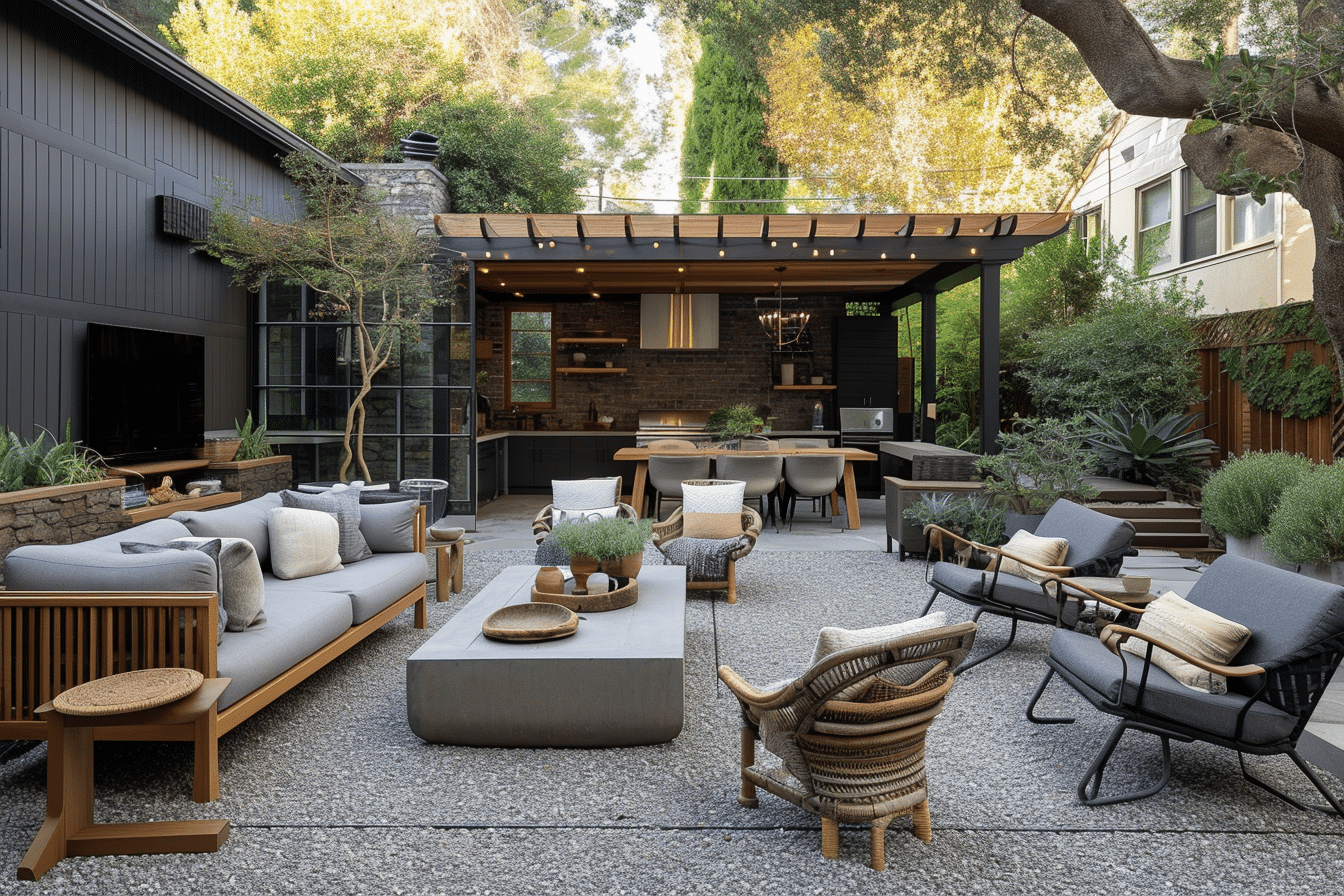
Outdoor Furniture Arrangement: Easy Tips for a Stylish Backyard
Outdoor furniture arrangement is an essential aspect of creating the perfect outdoor oasis for your home. A well-designed layout not only enhances the visual appeal of your space, but also improves its functionality. Just like indoor spaces, outdoor areas also require thoughtful consideration to achieve a harmonious flow and maximum comfort.
While planning your outdoor space, it’s important to understand the basics of furniture arrangement to ensure that seating areas promote conversation and relaxation. Material and durability considerations also play a key role in selecting pieces that can withstand various weather conditions and last for years to come. And, of course, no outdoor area would be complete without designing for comfort and style, as well as providing the perfect setting for dining and entertaining.
Key Takeaways from Outdoor Furniture Arrangement
- A thoughtfully arranged outdoor space promotes functionality and visual appeal
- Consider durable materials when selecting furniture to withstand the elements
- Provide comfortable seating options and inviting dining areas for entertaining guests
Planning Your Outdoor Space
Assessing the Patio or Garden Area
Before diving into the world of outdoor furniture arrangement, it’s essential to assess the available space in your patio or garden area. Start by measuring the dimensions of the area and take note of any existing structures or features, such as trees or built-in benches. This information will help you determine the best furniture layout for your outdoor space. Don’t forget to consider factors like sun exposure and wind direction, which can heavily influence the comfort and usability of your outdoor arrangement.
Choosing the Right Furniture Pieces
Selecting the right furniture pieces for your outdoor space is crucial, as it’ll help create an inviting and comfortable atmosphere. When shopping for outdoor furniture, there are a few factors to consider:
- Material: Choose durable materials like aluminum, teak, or wrought iron that can withstand the elements and require minimal maintenance.
- Functionality: Opt for pieces that serve multiple purposes, such as a storage coffee table or a sectional sofa that can be arranged in various layouts.
- Style: Go for a cohesive look by selecting furniture that complements your home’s architecture and your personal style.
Here are some popular furniture options for your outdoor space:
- Dining table and chairs: Perfect for outdoor meals and entertaining.
- Sectional sofa or loveseat: Offers ample seating while maximizing space.
- Loungers or reclining chairs: Ideal for relaxation and sunbathing.
- Side tables: Provides additional surface for beverages, snacks, or decorations.
Creating a Focal Point
Establishing a focal point in your outdoor space will elevate the visual appeal and make it more inviting. A few ideas for creating a focal point include:
- Fire pit or fireplace: Adds warmth and creates an inviting gathering spot.
- Water feature: Introduces soothing sounds and a calming atmosphere.
- Sculpture or art piece: Enhances the aesthetic appeal and adds interest.
Once the focal point is chosen, arrange the furniture pieces around it to create a cozy and inviting atmosphere. Make sure there’s enough space between the pieces for easy movement and avoid overcrowding or cluttering the area.
Overall, planning your outdoor space requires careful consideration of the available area, selecting appropriate furniture pieces, and creating a visually appealing focal point. By following these steps, you’ll create a functional and enjoyable outdoor space that will provide years of enjoyment.
Furniture Arrangement Basics
Understanding Traffic Flow
When planning your outdoor furniture arrangement, it’s essential to consider how people will move through the space. You want to create a comfortable and functional layout that allows for easy circulation and avoids awkward bottlenecks. Ideally, you should leave enough room for people to walk around the seating and allow for smooth traffic flow between key areas like the grill, dining table, and lounge chairs.
Balancing Space and Furniture
Another crucial aspect of arranging your outdoor furniture is striking the right balance between the available space and the furniture you want to incorporate. To achieve this balance, consider the scale of your furniture pieces and avoid overcrowding the area. It’s important to leave enough room for movement and activities, without sacrificing comfort and style. To help visualize the space, you can use tools like:
- Graph paper: Draw a scaled plan of your outdoor space, including measurements of your furniture, to easily see how the pieces will fit together.
- Markers and tape: Mark out the furniture placement directly onto your patio, adjusting as needed to ensure a comfortable flow of traffic.
Utilizing Modular Seating
Modular seating can be a game-changer when it comes to planning your outdoor furniture arrangement. With the flexibility to reconfigure and adapt the seating as needed, modular seating allows you to customize your layout to accommodate different events and activities. Some benefits of using modular seating include:
- Versatility: Switch up your arrangement to create a cozy conversation nook, an open lounge area, or accommodate larger gatherings.
- Space-saving: Combine or break apart modular pieces to optimize the use of space and avoid overcrowding.
In summary, to create a successful outdoor furniture arrangement, focus on understanding traffic flow, balancing space and furniture, and utilizing modular seating. By taking these factors into consideration, you can craft a welcoming and functional outdoor space for you and your guests to enjoy.
Material and Durability Considerations
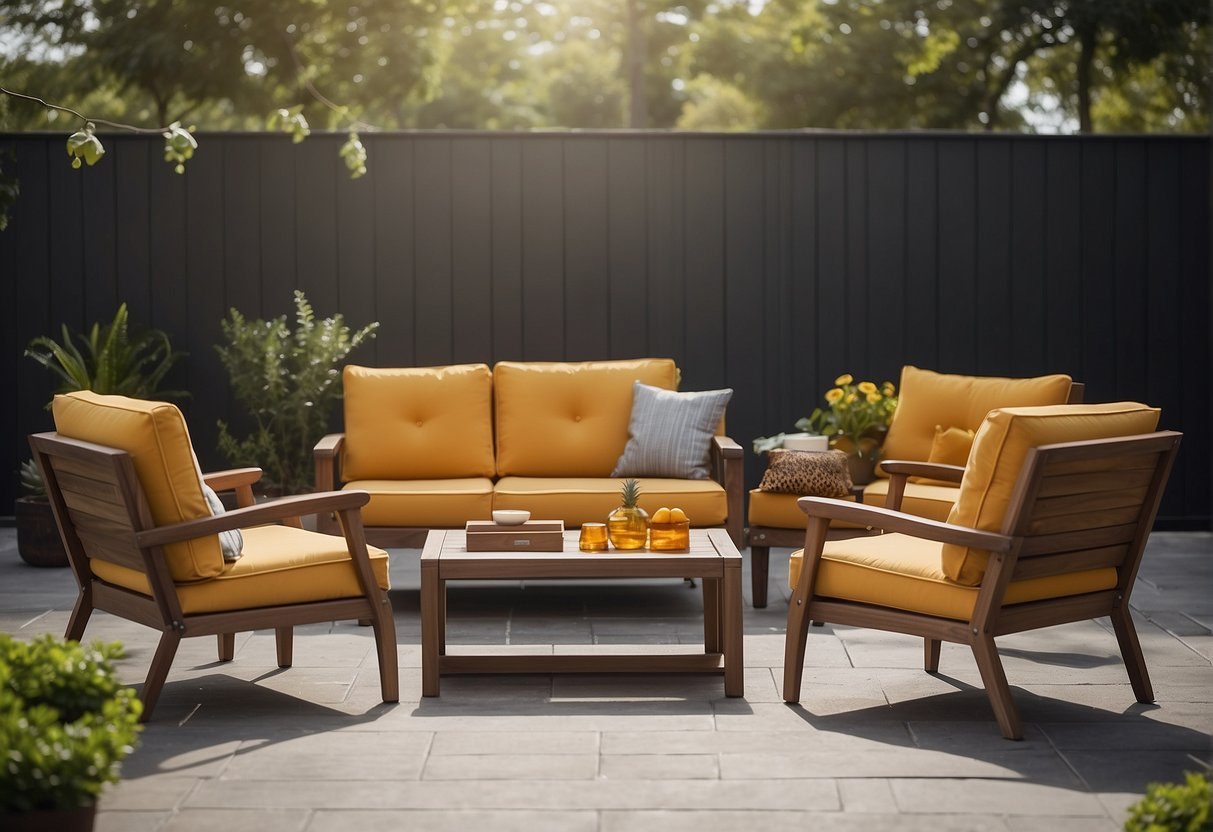
Wooden Furniture Choices
When it comes to outdoor furniture materials, wood is a popular choice. There are several types of wooden furniture to consider, such as teak and cedar. Teak is known for its durability, resistance to rot, and low maintenance, making it an ideal option for long-lasting outdoor furniture. Cedar, on the other hand, is a lighter and more affordable option. It’s also resistant to moisture, decay, and insect damage. However, cedar’s lifespan might not be as long as teak.
Metal and Wicker Options
Another popular material choice for outdoor furniture is metal. Metal furniture, particularly aluminum, is lightweight, durable, and requires little to no maintenance. Wrought iron is another metal option, but it can be prone to rust if not maintained properly. To keep your wrought iron furnishings in good shape, it’s essential to apply a rust-resistant coating and store them in a dry place when not in use.
Wicker furniture is another trendy option for outdoor spaces. Wicker that is made from synthetic materials such as resin or polyethylene is generally more durable than natural wicker and resistant to weather-related damages.
Weatherproofing for Longevity
Regardless of the material, it’s important to properly weatherproof your outdoor furniture to extend its lifespan. For wooden furniture, applying a sealant or varnish will protect the wood from moisture and sun exposure. Metal furniture, especially wrought iron, should be coated with a rust-resistant paint or spray to prevent corrosion. Additionally, using weatherproof covers will shield your outdoor furniture from the elements during harsh weather conditions.
A key aspect of maintaining your furniture’s durability is proper care and storage. When not in use, especially during winter months, storing your furniture indoors or in a sheltered area will help prolong its life and keep it looking great for years to come.
Designing for Comfort and Style
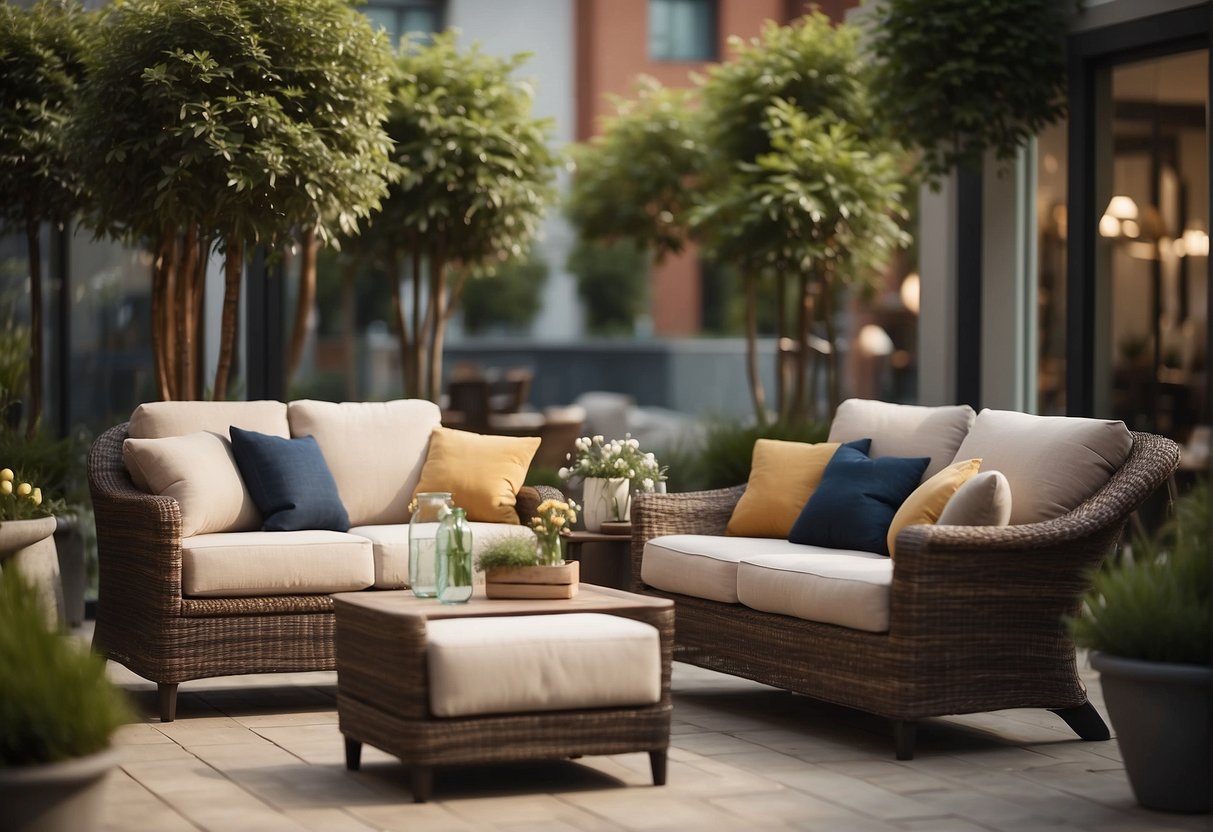
Selecting Cushions and Throws
When it comes to outdoor furniture, comfort is key. One way to ensure your space is cozy and inviting is by selecting the right cushions and throw pillows. Start by choosing cushions that are made of weather-resistant materials like Sunbrella or Olefin, as they’re designed to withstand the elements.
Next, consider adding a variety of throw pillows in different shapes, sizes, and patterns. This not only adds a pop of color and personality but also increases the overall comfort of your seating arrangements. To create a cohesive look, try mixing and matching pillows that share a common color palette or design theme.
Here are some tips for selecting the right cushions and throws:
- Choose weather-resistant materials
- Mix and match different shapes, sizes, and patterns
- Stick to a common color palette or theme
Incorporating Outdoor Rugs and Lighting
An often overlooked but essential aspect of outdoor furniture design is the incorporation of outdoor rugs and lighting. Outdoor rugs serve a dual purpose: they provide comfort underfoot and help define different areas within your space. Look for rugs made from durable, water-resistant materials like polypropylene that can hold up against the elements.
To set the ambiance and make your outdoor space even more inviting, incorporate a variety of lighting options. Consider adding string lights overhead for a warm, festive atmosphere, or use lanterns and candles to create a more intimate setting. For added safety and functionality, don’t forget to include pathway lights to guide your way.
Follow these tips to enhance your outdoor space with rugs and lighting:
- Opt for durable, water-resistant rug materials like polypropylene
- Use a mix of string lights, lanterns, candles, and pathway lights
- Consider the desired atmosphere when choosing lighting options
By following these guidelines and prioritizing both comfort and style, you’ll create an outdoor space that you and your guests will love to spend time in. Remember, the key is to combine functional elements like weather-resistant cushions, outdoor rugs, and versatile lighting with aesthetically pleasing designs that reflect your personal taste.
Dining and Entertaining Outdoors
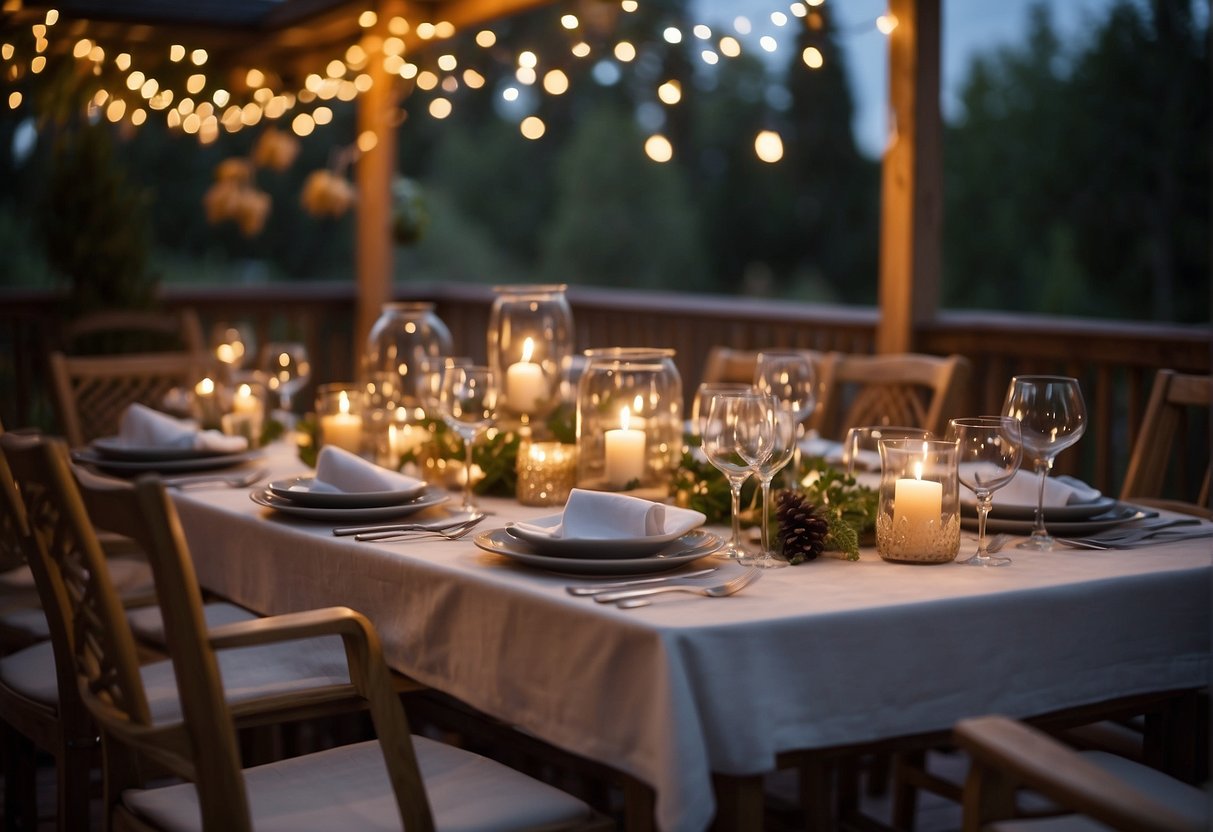
Arranging for Outdoor Dining
Creating an inviting outdoor dining area can be a delightful addition to one’s home. To start, select a spacious and comfortable dining set. Choose a dining table and chairs that complement the outdoor space and provide enough seating for family and friends.
When arranging the outdoor dining area, make sure to:
- Place the dining table and chairs on a flat surface for stability;
- Provide enough space between the seating and other outdoor features (e.g., firepit, pool, garden) to allow for easy movement;
- Offer ample lighting through a combination of candles, lanterns, or string lights;
- Include an umbrella or a shade to protect the diners from direct sunlight or rain.
Setting Up for Social Gatherings
Outdoor social gatherings are a great way to enjoy warm weather and entertain guests. To set up an inviting outdoor space for socializing, consider the following:
Seating arrangements: Offer a mix of seating options, including individual chairs, benches, and outdoor sofas, so that guests can mingle and find their comfort zone.
Ambiance: Create a cozy ambiance by adding soft lighting, such as string lights, lanterns, or candles.
Entertainment: Designate a specific area for entertainment, like an outdoor bar or a game corner, where guests can gather and engage in activities like:
- Board games
- Foosball table
- Outdoor movie screenings
Food and refreshments: Set up a designated serve-yourself station for drinks and appetizers. Be sure to include enough tables, plates, napkins, and utensils to accommodate all guests.
- With these ideas in mind, one can easily create a beautiful outdoor space for dining and entertaining guests.
Accessorizing and Decor
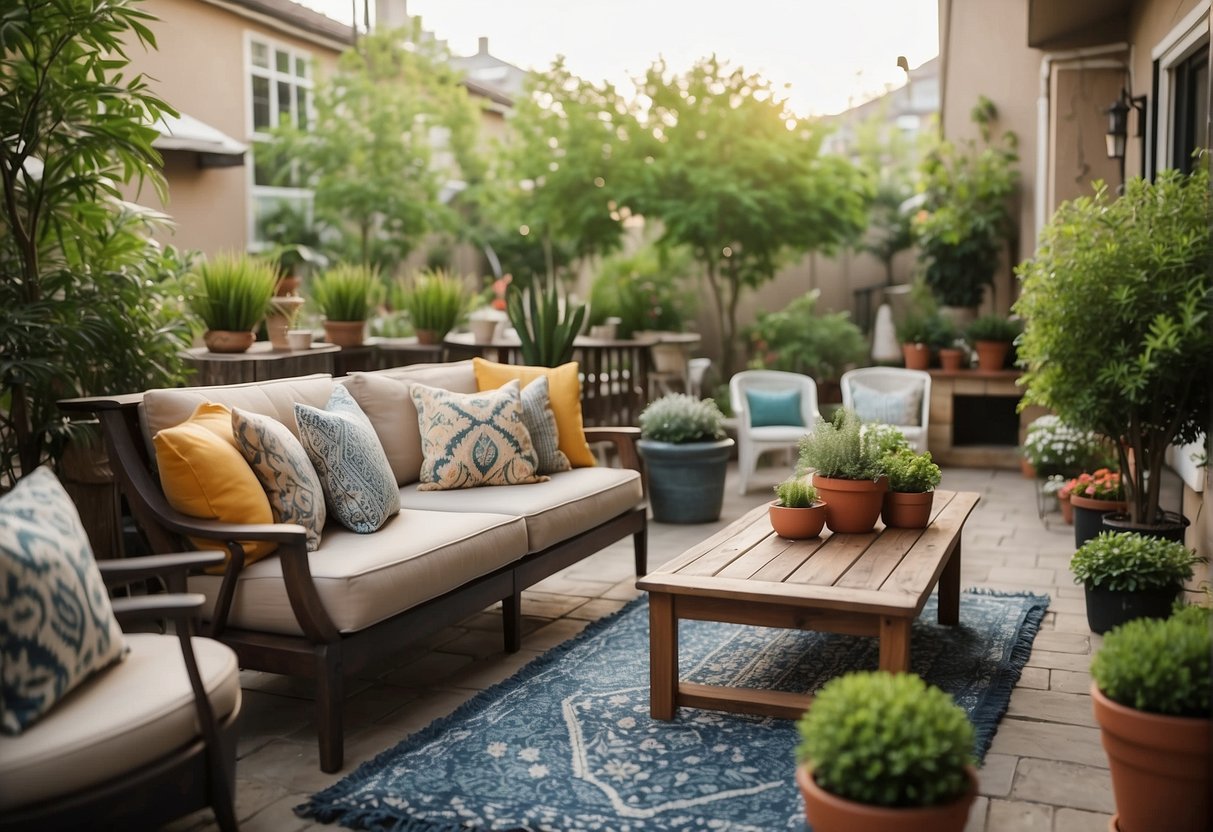
When it comes to outdoor furniture arrangement, accessorizing and incorporating decor items is essential for creating an inviting and functional space. This section will guide you through choosing the right planters and greenery, as well as adding functional décor items to enhance your outdoor living area.
Choosing Planters and Greenery
One of the most effective ways to elevate your outdoor space is by adding planters and greenery. Not only do they bring life and color to your patio, but they also improve air quality. Consider the following when selecting planters and plants for your space:
- Size: Choose planters that are proportional to your outdoor furniture, neither too small nor too large.
- Material: Opt for planters made of durable materials, such as concrete, plastic, or metal, to withstand outdoor conditions.
- Style: Pick planters that complement your furniture, either by color or design.
- Plants: Select low-maintenance, outdoor-friendly plants like succulents, ferns, or ornamental grasses that thrive in your region.
Incorporate greenery by strategically placing potted plants around seating areas, along edges or corners, and even as a centerpiece for tables.
Adding Functional Decor Items
Accessorizing your outdoor space with functional decor items not only provides visual interest but also increases your space’s functionality. Consider some of the following options:
- Umbrellas: Umbrellas offer shade and protect users from harmful UV rays. They come in various sizes, designs, and materials. Choose an umbrella that complements your outdoor furniture and offers adequate coverage.
- Outdoor rugs: Rugs designed for outdoor use are an excellent way to add color or texture to your space while also providing comfort underfoot.
- Pillows and cushions: To make your outdoor seating more comfortable, add weather-resistant pillows and cushions in coordinating colors or prints.
- Outdoor lighting: Illuminate your outdoor space with lanterns, string lights, or solar-powered lamps to create a cozy, inviting atmosphere during the evenings.
- Storage solutions: Functional storage options, like storage benches or deck boxes, can help keep your outdoor space organized while serving as additional seating.
Remember, when choosing accessories and decor items for your outdoor furniture arrangement, select those that not only enhance the aesthetics but also improve functionality and comfort.
Maintenance and Storage Solutions
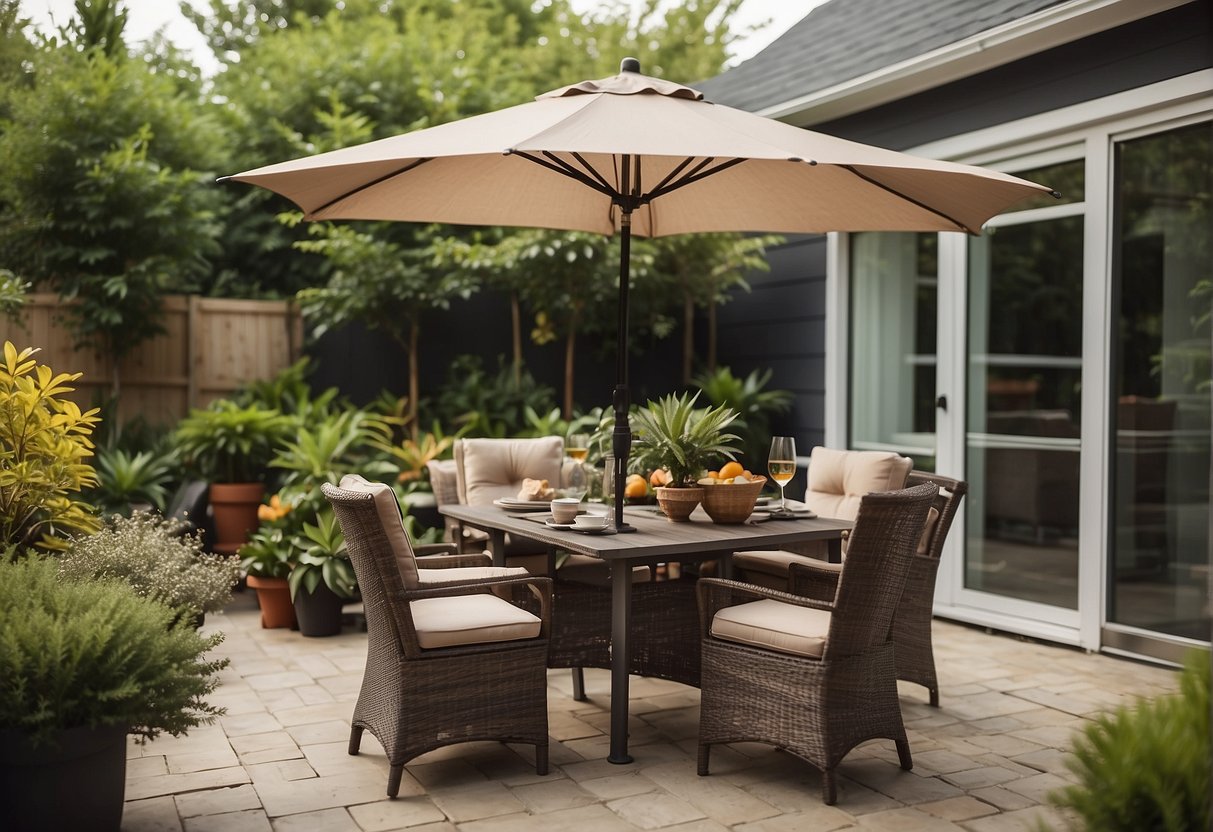
Cleaning and Care Tips
Outdoor furniture is designed to be durable and withstand various weather conditions. However, to keep it looking good and maintain its longevity, regular cleaning and care are essential.
For most outdoor furniture materials, a simple solution of warm water and mild dish soap will do the trick. Use a soft brush to gently scrub the surfaces and rinse thoroughly with a garden hose. Be cautious of using any harsh chemicals or abrasives that might damage the material.
Cushions and fabrics require a more delicate approach. They should be removed and cleaned according to the manufacturer’s instructions. A typical method is spot cleaning with a damp cloth and mild soap. Allow them to air dry completely before storing or reattaching to the furniture.
Metal furniture can develop rust if left untreated. To prevent this, sand away any rust spots, clean the surface, and apply a rust-inhibiting primer and topcoat.
Storing Outdoor Furnishings
Proper storage is crucial in extending the life of your outdoor furniture. Consider these tips for cushion storage, outdoor cabinets, and general furniture storage:
Cushion storage: Although outdoor cushions are designed to resist moisture and mildew, it’s best to store them in a dry and ventilated area when not in use. Look for outdoor cushion storage boxes that are weather-resistant and provide ample space for all your cushions.
Outdoor cabinets: Outdoor cabinets are a clever and practical solution for storing smaller outdoor items like pool toys, garden tools, and even barware. Make sure the cabinet is constructed from weather-resistant materials and has proper ventilation to keep the contents fresh and dry.
Furniture covers: If bringing your furniture inside is not an option, invest in high-quality, durable covers to protect your investment. Choose covers that are water-resistant, have UV protection, and are tailored to fit your furniture securely.
Off-season storage: During winter months or extended periods of disuse, it’s best to store your outdoor furniture in a shed, garage, or another sheltered area. This will expand its durability and protect it from damage due to harsh weather conditions.
By adhering to these maintenance and storage tips, you’ll ensure your outdoor furniture remains pristine and ready for relaxation whenever you need it.
Luxury Specialist at McGraw Realtors
With a diverse background, including a career as an Air Force fighter pilot and entrepreneurship, Bill transitioned to real estate in 1995. Co-founding Paradigm Realty with his wife, Charlene, he quickly rose to prominence in Oklahoma City’s luxury real estate scene. Now, as one of the top agents with annual sales surpassing $20 million, Bill’s dedication to exceptional service remains unparalleled. With a legacy spanning over two decades in the industry, Bill’s expertise and commitment make him a trusted name in luxury real estate.